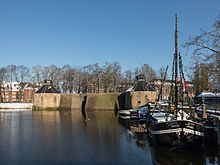BREDA
Ralph Behouden
Night Mayor Ralph Behouden.
2016-2018
 prev: 2014-2016 Martijn Bonk Gulden
prev: 2014-2016 Martijn Bonk Gulden
 prev: 2014-2016 Martijn Bonk Gulden
prev: 2014-2016 Martijn Bonk Gulden
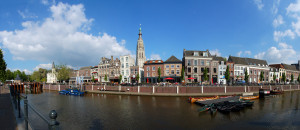 Breda (Dutch pronunciation: [breːˈdaː] (
Breda (Dutch pronunciation: [breːˈdaː] (History
See also: Timeline of Breda
| Historical population | ||
|---|---|---|
| Year | Pop. | ±% p.a. |
| 1437 | 4,870 | — |
| 1496 | 6,025 | +0.36% |
| 1640 | 9,500 | +0.32% |
| 1740 | 11,000 | +0.15% |
| 1795 | 8,250 | −0.52% |
| Source: Lourens & Lucassen 1997, pp. 40-41 | ||
Residence city
The acquisition of the city by the House of Orange-Nassau marked its emergence as a residentiestad (residence city). The presence of the Orange-Nassau family attracted other nobles, who built palatial residences in the old quarters of the city. The most impressive one, built by the Italian architect Thomas Vincidor de Bologna for the first Dutch prince, was the first renaissance-style palace built north of the Alps. In the 15th century the city's physical, economic and strategic importance expanded rapidly. A great church was built in Brabantine Gothic style with a gallant 97 metres (318 ft) high tower, called Grote Kerk (main church) or alsoOnze Lieve Vrouwe Kerk (Church of Our Lady). In 1534 Henry III of Nassau-Breda rebuilt the modest medieval fortifications in impressive style.
Haultpenne's soldiers vent their fury upon the citizens of Breda in 1581
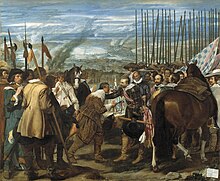
Surrender of Breda, by Diego Velázquez.
Stuart exiles
The exiled Stuart pretender Charles II of England resided in Breda during most of his exile during the Cromwellian Commonwealth and Protectorate, thanks to the proximity of Charles's sister Mary, Princess Royal, the widow of Prince William II of Orange. Based mostly on suggestions by Parliamentarian General George Monck, Charles II's Declaration of Breda (1660) made known the conditions of his acceptance of the crown of England which he was to accept/resume later in the same year. The Treaty of Breda was signed in the city, July 31, 1667, bringing to an end the Second Anglo-Dutch War in which the Dutch faced the same Charles II who had been their guest. Between 1746 and 1748 it was the site of the Congress of Breda a series of talks between Britain and France aimed at bringing an end to the War of the Austrian Succession, which ultimately led to the signing of the Treaty of Aix-la-Chapelle.World War II
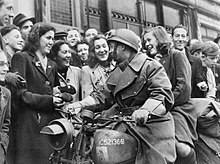
Polish soldiers welcomed by the residents of Breda, 1944
Administration
- Breda (city) (~170,000)[9]
- Ginneken (former village absorbed by city agglomeration)
- Princenhage (former village absorbed by city agglomeration)
- Prinsenbeek (~11,500) (added at the municipal reorganization in 1997)
- Bavel (~7,000) (added at the municipal reorganization in 1997)
- Teteringen (~6,500) (added at the municipal reorganization in 1997)
- Ulvenhout (~4,700) (added at the municipal reorganization in 1997)
Administration
The city of Breda is divided in 7 city sectors:- Breda Centrum (Centre)
- Breda West (West)
- Breda Noord-West (Haagse Beemden) (Northwest)
- Breda Noord ( North)
- Breda Oost (East), which includes the Zandberg neighborhood[10]
- Breda Zuid-Oost (Southeast)
- Breda Zuid (South)
Topography
 Topographic map image of the city of Breda, March 2014. Click to enlarge.
Topographic map image of the city of Breda, March 2014. Click to enlarge.
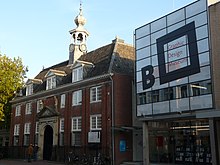
Museum of the Image (MOTI)
Economy
Historically, economic activities were mainly industrial. Breda was a center of the food- and drink industry. Companies like Hero (lemonade), Van Melle (Mentos), De Faam (liquorice) and Kwatta (chocolate) are famous throughout Western Europe. Breda also had a sugar factory, supplying its best-known products. BREDA beer is a world-renowned drink that is made in this region. Also, Breda formerly housed the largest brewery in the Netherlands (Oranjeboom). Interbrew, the Belgian owner of the brewery, closed the brewery in 2004. With the closing of Oranjeboom Brewery, Breda beer production was moved to both Bremen and Leuven, until 2008 when Randalls Brewery (in Guernsey) acquired the licence.[11] Guernsey is now the only place in the world where draught Breda is brewed.[12] However, the decline of industrial activity did not harm the city's economy. Nowadays, Breda is a service oriented economy based on business, trade and logistics. A growing number of international companies choose to establish their head office for Benelux operations in Breda. Examples of these companies are Abbott Laboratories,General Electric, ExxonMobil, Texaco, Scania, Dockwise, Toshiba, Alfa Laval, Krohne Oil & Gas, General Motors, Ritchie Bros. Auctioneers and Amgen. Also, the food industry is still largely represented by companies such as Hero, Perfetti Van Melle, Anheuser-Busch InBev and Royal Cosun. Furthermore, the city is host to the headquarters of the Royal Netherlands Air Force. Because of its central location between the ports of Antwerp and Rotterdam, the city also attracts logistics companies. The main shopping areas of Breda are the city centre and the southern part of Breda. Known shopping centres are De Barones and 't Sas. Major shopping streets are the Eindstraat, Ginnekenstraat, Wilhelminastraat and Ginnekenweg. A market is held on the Grote Markt every Tuesday and Friday from 9 AM to 1 PM. A book and antique market is held on Wednesday from 9 AM to 5 PM.Main sights
The city center contains old buildings and portions of the singels (moats) and the harbour. Focal point is the Grote Markt, the main square with pubs and sidewalk cafes. Park Valkenberg is a major public park, halfway between the main railway station Breda and the Grote Markt. Major historic buildings include:- The Grote Kerk (Large Church) or Onze Lieve Vrouwe Kerk (Church of Our Lady), a major example of the Brabant style of Gothic Architecture.
- The Castle of Breda.
- The Begijnhof, a Beguinage.
- Saint Anthony's Cathedral (Sint-Antoniuskathedraal), the cathedral church of the Roman Catholic Diocese of Breda.
- City hall.
- The Spanjaardsgat, a 16th-century water gate.
Culture
The spoken language is West Brabantian, which is very similar to colloquial Dutch. Musical events are held in the Chasse Theater. Redhead Day is a festival that takes place each first weekend of September. The two-day festival is a gathering of people with natural red hair, but is also focused on art related to the colour red. Activities during the festival are lectures, workshops and demonstrations. The festival attracts attendance from 20 countries and is free due to sponsorship of the local government. Furthermore, some people refer to Breda as the opposite of burning man.Museums
Breda hosts the following museums:- Breda's Museum
- Begijnhof Breda Museum
- Generaal Maczek Museum
- Bier Reclame Museum
- MOTI (Museum of the Image) before the Graphic Design Museum[13]
- NAC Museum
- Heemkundig Museum Paulus van Daesdonck
- Museum Oorlog & Vrede [War and Peace Museum]
- Stichting Princenhaags Museum
Events
- Breda Dancetour (House Music)
- Carnaval
- Breda Jazz Festival
- Breda Photo
- Singelloop Breda
- Redhead Day (Roodharigendag)
- Breda Barst
Sport
- Breda's Football club, NAC Breda, plays in the second highest Dutch league, the Eerste Divisie after being relegated from the 2014-15 Eredivisie via play-offs.
- Breda's Rugby club, Bredase Rugby Club
- Breda's athletics club, A.V. Sprint, is the largest club of its kind in the Netherlands.
- Breda's Golden Glory, is a kickboxing camp.
- Every year in the month of October, the Bredase Singelloop is a major road running event on the half marathon distance with a field of national and international athletes.
Notable residents
- Charles II of England Lived in Breda for most of his exile during the Commonwealth of England. His sister, Mary, Princess Royal and Princess of Orange was widow of Stadtholder William II, Prince of Orange and co-regent for their son William III sovereign Prince of Orange and later King of England, Scotland and Ireland.
- Although neither of them were long-term residents of Breda, it was there, in 1618, that the young René Descartes (at the time, a soldier in the army of Prince Maurice of Nassau) first met, and had extensive conversations with, Dutch philosopher, mathematician, and scientist Isaac Beeckman (then temporarily resident in the town). This interaction with Beeckman seems to have changed the course of Descartes’ intellectual life, eventually leading him to the major innovations in mathematics, science, and philosophy for which he is famous.[14]
- "Colonel" Thomas Parker, the manager of Elvis Presley, was born and raised in Breda as Andreas Cornelius van Kuijk.
- Adriaen Cornelissen van der Donck (c. 1618 – 1655), first lawyer in the Dutch colony of New Amsterdam; a polyglot
- Breda is the birthplace and home to several internationally famous electronic dance music artists including R3hab, Dannic, W&W along with former and current World No.1 DJs — Tiësto and Hardwell. The title of the their 2011 collaboration track, Zero 76 is derived from the dialing code of Breda.
- Breda is also the birthplace of former Olympic swimmer Karin Brienesse and former field hockey player Remco van Wijk, who twice won the gold medal at the Summer Olympics with the Dutch National Team: 1996 and 2000.
- Breda is the city where the Dutch composers Daan Manneke and Kristoffer Zegers live.
- The Dutch football international Pierre van Hooijdonk played in Breda. Other formerly international Dutch football players from NAC Breda were Antoon (Rat) Verlegh, Kees Rijvers, Kees Kuijs, Leo Canjels, Daan Schrijvers, Frans Bouwmeester, Nico Rijnders, Ad Brouwers, Bertus Quaars, Martin Vreysen and Ton Lokhoff.
- Ramon Dekkers, Muay Thai and Kickboxing World Champion, was born and died in Breda.
- Home to world-renowned DJs Hardwell, DANNIC and Tiesto.





